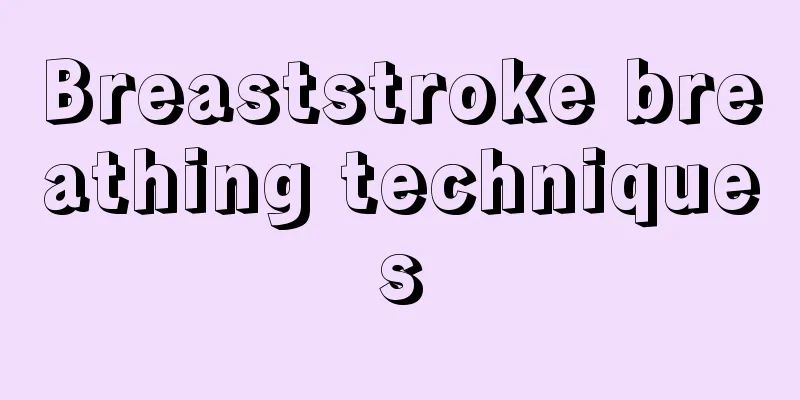Breaststroke breathing techniques

|
In life, many people particularly like swimming as a sport, because when swimming the muscles of the whole body are moving, which is especially helpful for fitness and weight loss. Breaststroke is also a type of swimming sport, but breaststroke requires holding your breath in the water, so you must master the breathing skills when breathing. Learning to swim is particularly beneficial and helpful in life, so what are the breathing techniques for breaststroke? There are only three steps to breathing in swimming: hold your breath in water, exhale in water, and inhale above water. When exhaling, some coaches will teach you to exhale through the mouth, while some coaches will teach you to exhale through the nose, but all coaches will teach you to inhale through the mouth. If your coach asks you to inhale through your nose, then change it quickly! Holding your breath underwater Hold the edge of the pool, your partner's or your coach's hand and squat down with your head submerged in the water to practice holding your breath. Stand up after a while and then practice on your own without protection. The longer you can hold your breath, the better. If you feel any discomfort in your head, you should stop practicing to avoid injury. Exhaling in water Squat down with your hands on the pool wall or your companion's hand, submerge your head in the water, and then slowly exhale through your mouth (nose). It is best to exhale through your nose alone. After a while, he slowly stood up. The longer you exhale in the water, the better. Note: do not exhale intermittently. (Easy to choke on water) Water breathing When your head reaches the surface of the water, the first thing you should do is not to inhale immediately, but to spit out the water in your mouth and nasal cavity. That’s why the coach will say that there must be a “pop” sound. Although it’s a bit exaggerated, it can indeed help you avoid choking on water! Then open your mouth as wide as you can and inhale quickly. In fact, the inhalation action is not that complicated, because the lungs have the function of self-inhalation. All you have to do is open your mouth wide and feel the first half of the yawning action. Let’s take the breathing of breaststroke as an example to explain it in detail Since the pressure of water is much greater than that of air, holding your breath and exhaling in water are not as easy or natural as on land. So we can practice on land first. The longer you hold your breath and exhale, the more help it will be in learning other movements later. But you should practice slowly and don't exhale immediately after inhaling. When exhaling through your mouth (nose) in the water, in addition to paying attention to the rhythm, your elbows should be pulled towards your chest when paddling. This will naturally lift your head more. Otherwise, it will be very difficult to paddling hard. When you just learn how to breathe, you should breathe after three leg kicks. Some people also say that you should practice leg kicking first, and if you can kick about 8 meters in one breath without moving your hands, then practice other things. One reason for not being able to breathe is that the leg kicking efficiency is too low, and your whole body sinks. If you don't stroke correctly, your head will be out of the water for very little time, and if you don't exhale sufficiently, it will be difficult to breathe when there is some water on your face and mouth. Kicking your legs three times can bring your body closer to the water surface, and you can come out of the water by just raising your head. Stretch your arms out straight, don't paddle, kick your legs three times, and when you feel your feet are basically above the water, swing your arms straight down, lift your head up high, open your mouth, take a breath of air and swallow it. When you switch to a breath, there will be a qualitative change, and then you should gradually transition to kicking your legs once, take a breath, improve the efficiency of paddling and kicking your legs, glide for a while after taking a breath, relax and maintain the rhythm. |
<<: My left shoulder and ribs hurt every time I breathe
>>: Why do I feel tired breathing
Recommend
Which is better, washing your face with hot water or cold water?
In people's daily life, they wash their faces...
How to treat insomnia caused by qi and blood deficiency
Qi and blood deficiency is a health problem that ...
My ears feel swollen and blocked, what's going on?
The ear is a very important part of the human bod...
How to choose a frying pan
Cooking with a pan is closely related to our live...
This is how you should handle a positive Mycoplasma pneumoniae antibody
Pneumonia is an extremely serious disease for chi...
How many years will it take for the nerves to recover after cerebral hemorrhage
As we age, our blood has many problems. Cardiovas...
Does Black Ancient Vine Longevity Tea have any side effects?
Tea is a relatively healthy drink, and many peopl...
How to treat alopecia areata
Alopecia areata is a phenomenon of local hair los...
What's going on with yellow eyeballs?
When you find that your eyeballs are turning yell...
Learn the correct way and time to brush your teeth
Everyone knows how to brush their teeth, but are ...
The difference between hazelnuts and macadamia nuts
In our daily life, many people like to eat nuts. ...
How are blackheads formed? Causes of blackheads
Many friends have blackheads on their noses, whic...
What are the three painful places in the early stage of laryngeal cancer
In the early stages of laryngeal cancer, there ma...
Deep second degree burn recovery process
The symptom of deep second-degree burns is a more...
Can you drink liquor when you have a cold? Wine lovers must know this
Can I drink white wine when I have a cold? This i...









